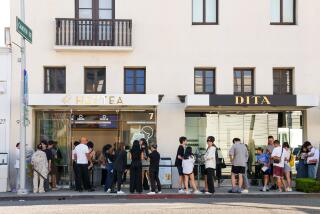Tea Totaler : Lipton Is Counting on Its Beverage Bars to Be the Next Big Thing
- Share via
Wake up! Time for a cup of . . . tea?
Taking its cue from the rise of cafes and juice bars, Thomas J. Lipton Co. is getting in front of what it hopes is the next trend: teahouses. In Pasadena last month, the unit of Unilever opened the first teahouse in what it hopes will become a chain.
With its light wood and chrome interior, the teahouse seems inspired by Starbucks, the trendy coffee chain. Lipton teahouse patrons can order scones and a tea latte--a drink made from tea, milk, cinnamon and other spices.
However, the real inspiration for the teahouse isn’t Starbucks, but Procter & Gamble Co. and General Foods--two coffee giants that missed out on the cafe trend. Englewood Cliffs, N.J.-based Lipton, the nation’s largest tea company with 35% of the $3.3-billion market, isn’t taking any chances with tea.
British-based Unilever said it zeroed in on this region for its pilot teahouse because Southern Californians tend to try new things. It chose Pasadena’s Old Town area because it has heavy foot traffic, with a mixture of locals and tourists.
Lipton thinks America may be ready for teahouses. Tea sales have been growing by 5% a year, thanks to New Age beverages like Snapple and Fruitopia and fruity herbal teas from Celestial Seasonings.
New York beverage consultant Tom Pirko believes teahouses could be the next chapter in the beverage bar trend.
“There is a mystique to tea,” he said. “It is seen as refreshing, soothing and as doing good things to your psyche.”
But teahouses face obstacles, not the least of which is nabbing male customers. Tea is viewed as a women’s beverage. According to Lipton, 70% of hot-tea drinkers are women.
Another problem facing teahouses is that coffee, not tea, is the wake-up beverage of choice. A survey by the National Coffee Assn. shows that while 49% of adults drink coffee, only 32% drink tea. And both beverages lag soft drink consumption.
*
Lipton’s biggest hurdle could be that it is perceived as a mass-market brand, lacking the premium image of, say, Starbucks.
Lipton is trying to make its teahouse offerings distinctive. The teahouse sells 49 kinds of loose teas that Lipton does not sell through other channels. The familiar Lipton box with Sir Thomas’ picture is nowhere in sight. Canned Lipton iced tea isn’t available.
“The idea is to show consumers how interesting and diverse tea can be,” said Gasper Ferraro, director of finance for Lipton’s food service division.
Screening for the Fences
Virtual advertising is coming to Los Angeles Dodgers games.
Though the club has avoided advertising in its stadium, it appears ready to insert electronic billboards in television broadcasts, visible only to viewers at home.
Digital mapping technology allows advertisers to electronically “paint” their messages on stadium walls or fields during live broadcasts. Using a system from New Jersey-based Princeton Video Imaging, the San Francisco Giants last season created electronic billboards behind home plate. Giants fans watching home games on TV saw billboards for Nissan Motors USA, Kellogg Co. and GTE Corp. Fans attending the game saw a blank wall.
The Dodgers plan to use the PVI system to beam electronic billboards on the outfield wall, said Brent Shyer, director of broadcasting for the Dodgers. Other details remain to be worked out with TV rights holders KTLA Channel 5 and Fox Sports West 2.
KTLA general sales manager Blaine Rominger said virtual ads will probably appear in the 10 home games broadcast on Channel 5. He said negotiations are underway to include virtual ads in some away games.
Shyer thinks Dodger fans will accept the virtual billboards, which he considers less intrusive than stadium signage.
“Compared to painted permanent signage in ballparks, which is always there and which a lot of clubs have, we think this is more beneficial for fans,” he said. “People watching TV do not see it constantly, and people in the stadium itself would not be seeing it at all.”
Denise Gellene can be reached at denise.gellene@latimes.com or by fax at (213) 237-7837.
More to Read
Eat your way across L.A.
Get our weekly Tasting Notes newsletter for reviews, news and more.
You may occasionally receive promotional content from the Los Angeles Times.










